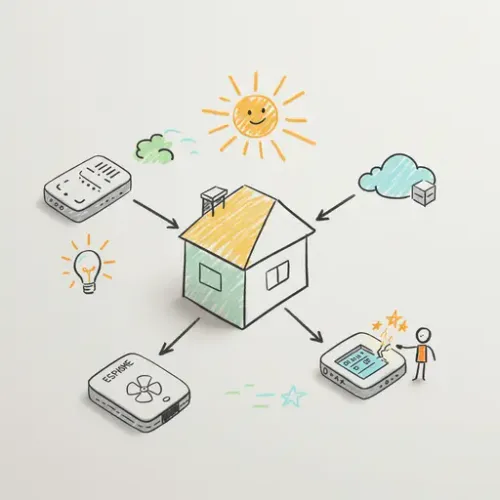Building Offline-Resilient Automations: Critical Local Control with ESPHome in Home Assistant

NGC 224
DIY Smart Home Creator
Introduction: The Imperative of Offline Resilience in Your Smart Home
In the evolving landscape of smart home automation, the central hub – often Home Assistant – is a powerful orchestrator. However, this centralized reliance presents a critical vulnerability: what happens when your Home Assistant server crashes, your network goes down, or even your internet connection is lost? Suddenly, your essential automations – the lights, the heating, the security sensors – become unresponsive. For tech enthusiasts and practical homeowners alike, this single point of failure is a source of frustration and, for critical systems, a significant concern.
This article dives deep into leveraging ESPHome to build a truly robust and offline-resilient smart home. We’ll move beyond mere device integration and focus on pushing intelligence to the edge, enabling your devices to perform critical functions autonomously, even without Home Assistant’s constant supervision. This approach ensures your smart home remains functional and reliable, providing peace of mind and an enhanced user experience, regardless of upstream system availability.
Step-by-Step Setup: Creating Your First Offline-Capable ESPHome Device
The core idea is to embed essential logic directly into the ESPHome device’s firmware. This means the device can react to local inputs (like a button press or a sensor reading) and control local outputs (like a relay or an LED) without needing to communicate with Home Assistant.
1. Choosing Your Hardware & Initial ESPHome Setup
Start with a suitable ESP32 or ESP8266 board (e.g., NodeMCU ESP32, Wemos D1 Mini ESP8266). Ensure you have the ESPHome add-on installed in Home Assistant or the ESPHome CLI for a standalone setup.
Here’s a basic ESPHome configuration (my_resilient_device.yaml) to get started:
# my_resilient_device.yaml
esphome:
name: my-resilient-device
friendly_name: My Resilient Device
esp32:
board: nodemcu-32s # or esp01_1m for ESP8266
# Enable Web Server for easy configuration and logging (optional but recommended)
web_server:
port: 80
# Enable Home Assistant API for seamless integration
api:
# Enable Over-The-Air (OTA) updates
ota:
# Wi-Fi configuration
wifi:
ssid: "YOUR_WIFI_SSID"
password: "YOUR_WIFI_PASSWORD"
manual_ip:
static_ip: 192.168.1.200 # Assign a static IP
gateway: 192.168.1.1
subnet: 255.255.255.0
# Optional: reconnect to Wi-Fi if connection is lost
reboot_timeout: 0s # Never reboot if disconnected
power_save_mode: LIGHT # Or NONE for faster response, but higher power usage
logger:
# Optional: Enable native API encryption for security
# api:
# encryption:
# key: <YOUR_API_ENCRYPTION_KEY>
# (Generate key using 'esphome pskey')
Flash this initial firmware to your ESP device. Once powered up, it will connect to your Wi-Fi and should be discoverable by Home Assistant.
2. Implementing Basic Local Control: A Resilient Light Switch
Let's create a smart light switch that works locally via a physical button, even if Home Assistant is offline. We'll use a relay for the light and a GPIO pin for the button.
# Add to my_resilient_device.yaml
binary_sensor:
- platform: gpio
pin:
number: GPIO12
mode: INPUT_PULLUP # Use internal pull-up resistor
name: "Physical Light Button"
id: physical_light_button
# When the button is pressed, toggle the light directly on the ESP
on_press:
- switch.toggle: my_resilient_light
filters:
- debounce: 50ms # Prevent multiple triggers from a single press
switch:
- platform: gpio
pin: GPIO13
name: "My Resilient Light"
id: my_resilient_light
# Optional: Set initial state on boot
restore_mode: RESTORE_DEFAULT_OFF # Restore to OFF after power cycle
on_boot:
# Ensure the light is off when the device boots up
- switch.turn_off: my_resilient_light
Upload this updated firmware. Now, pressing the physical button connected to GPIO12 will toggle the light connected to GPIO13. This action happens *entirely on the ESP device*, making it fully offline-resilient.
3. Integrating with Home Assistant
After uploading the new firmware, Home Assistant will automatically discover the device and its entities (binary_sensor.physical_light_button and switch.my_resilient_light). You can now control the light from Home Assistant, but crucially, the physical button will *still work* if Home Assistant is unavailable.
(Screenshot placeholder: Home Assistant Devices & Services showing ESPHome device discovered, with its entities.)
Troubleshooting Common Offline-Resilience Issues
Even with careful planning, issues can arise. Here’s how to diagnose and fix them:
Device Not Responding Locally
- Power Supply: Ensure the ESP device has a stable and sufficient power supply. Brownouts can cause erratic behavior.
- Wiring: Double-check all physical connections (button, relay). Use a multimeter if unsure.
- ESPHome Logs: Connect to the ESPHome dashboard or use the CLI to view live logs (
esphome logs my_resilient_device.yaml). Look for errors related to GPIO, or if theon_pressevents are even being detected. - Firmware Integrity: If recent changes were made, re-uploading known-good firmware can rule out software corruption.
Home Assistant Not Seeing ESPHome Device / Entities
- Network Connectivity: Verify the ESP device is connected to your Wi-Fi. Check its IP address via the ESPHome logs or your router's client list.
- mDNS/Bonjour: ESPHome relies on mDNS for discovery. Ensure your network allows mDNS traffic between the ESP device and your Home Assistant server. Some managed switches or router settings might block this.
- Firewall: Check if a firewall on your Home Assistant host is blocking incoming connections from the ESP device on port 6053 (ESPHome API).
- API Configuration: Ensure
api:is present and correctly configured in your ESPHome YAML. If you enabled encryption, ensure Home Assistant has the correct key. - IP Address Conflicts: If using a static IP, ensure no other device on your network uses the same address.
Unexpected Behavior on Home Assistant Downtime
The whole point of resilience is predictable behavior during outages. If your device behaves differently:
- Review ESPHome Logic: Thoroughly re-examine your
on_boot,on_press,on_state, andlambdaconditions within the ESPHome YAML. Is the device truly self-sufficient for its core function? Are there any hidden dependencies on HA? - State Restoration: For critical devices, consider
restore_modesettings for switches and lights.RESTORE_DEFAULT_OFForRESTORE_DEFAULT_ONcan ensure a known state after a power cycle. - HA Automations vs. ESPHome Automations: Be clear about which logic lives where. Logic that *must* work offline belongs exclusively in ESPHome. Logic that is desirable but not critical can live in Home Assistant.
Advanced Configuration & Optimization for Resilience
While basic local control is excellent, we can enhance resilience by allowing Home Assistant to influence local behavior without becoming a single point of failure. This means HA can set parameters, but the ESPHome device uses those parameters to operate autonomously.
1. Remote Configuration via Home Assistant (Maintaining Local Resilience)
Let's refine our resilient light switch with motion detection and allow Home Assistant to configure the 'off-delay' for the light. The motion detection and light control will still happen locally.
# Add to my_resilient_device.yaml
globals:
- id: motion_off_delay
type: int
restore_value: yes # Persist value across reboots
initial_value: 300 # Default to 5 minutes (300 seconds)
# Expose a Number entity to Home Assistant to configure the delay
number:
- platform: template
name: "Bathroom Motion Off Delay"
id: bathroom_motion_off_delay_ha
min_value: 10
max_value: 1800 # Max 30 minutes
step: 10
# When Home Assistant sets this number, update our global variable
on_value:
- globals.set:
id: motion_off_delay
value: !lambda 'return x;'
# On ESPHome boot, set the number in HA to the current global value
# This ensures HA always shows the current value stored on the ESP
state:
- lambda: 'return id(motion_off_delay).state;'
binary_sensor:
- platform: gpio
pin: GPIO4
name: "Bathroom Motion Sensor"
id: bathroom_motion_sensor
device_class: motion
# When motion is detected, turn on the light
on_press:
- light.turn_on: bathroom_light_relay
# When motion stops, turn off the light after the configurable delay
on_release:
- light.turn_off:
id: bathroom_light_relay
delay: !lambda "return id(motion_off_delay).state * 1000;" # Delay in milliseconds
output:
- platform: gpio
pin: GPIO5
id: bathroom_light_output_pin
light:
- platform: binary
output: bathroom_light_output_pin
name: "Bathroom Light Relay"
id: bathroom_light_relay
restore_mode: RESTORE_DEFAULT_OFF
With this setup, Home Assistant gains an input_number-like entity to adjust the motion off-delay. This value is stored directly on the ESP device (thanks to restore_value: yes on the global variable). If Home Assistant goes offline, the ESP will continue to use the *last configured delay* for its motion-activated light control, maintaining its resilience.
Real-World Example: HVAC Fan Control with Offline Fallback
Let's build a more complex, yet highly resilient, HVAC exhaust fan controller for a bathroom or utility room. This system will automatically activate based on humidity, offer a physical override, and allow Home Assistant to set the humidity threshold, all while maintaining core functionality offline.
Components: ESP32, DHT22/AM2302 (humidity/temperature sensor), 5V relay module, momentary push button, and an exhaust fan.
# Add to my_resilient_device.yaml
# Global variable for humidity threshold, configurable from HA
globals:
- id: humidity_threshold
type: float
restore_value: yes
initial_value: 70.0 # Default to 70%
- id: manual_override_active
type: bool
restore_value: yes
initial_value: false # Default to auto mode
# Expose a Number entity for the humidity threshold to Home Assistant
number:
- platform: template
name: "Bathroom Humidity Threshold"
id: bathroom_humidity_threshold_ha
min_value: 40
max_value: 90
step: 1
on_value:
- globals.set:
id: humidity_threshold
value: !lambda 'return x;'
state:
- lambda: 'return id(humidity_threshold).state;'
sensor:
- platform: dht
pin: GPIO16 # Connect DHT data pin to GPIO16
temperature:
name: "Bathroom Temperature"
id: bathroom_temp
unit_of_measurement: "°C"
humidity:
name: "Bathroom Humidity"
id: bathroom_humidity
unit_of_measurement: "%"
filters:
- filter_out: nan # Filter out invalid readings
# Local automation for humidity control
on_value:
- if:
# If humidity is above threshold AND not in manual override
condition:
and:
- lambda: return x > id(humidity_threshold).state;
- lambda: return !id(manual_override_active).state;
then:
- switch.turn_on: bathroom_exhaust_fan
- if:
# If humidity is below threshold with hysteresis AND not in manual override
condition:
and:
- lambda: return x < (id(humidity_threshold).state - 5.0); # 5% hysteresis
- lambda: return !id(manual_override_active).state;
then:
- switch.turn_off:
id: bathroom_exhaust_fan
delay: 1800s # Turn off after 30 minutes if humidity drops
binary_sensor:
- platform: gpio
pin:
number: GPIO12
mode: INPUT_PULLUP
name: "Bathroom Fan Physical Switch"
id: bathroom_fan_physical_switch
on_press:
- switch.toggle: bathroom_exhaust_fan # Toggle the fan physically
- if:
condition:
switch.is_on: bathroom_exhaust_fan
then:
# If fan is now ON (after press), activate manual override for 1 hour
- globals.set:
id: manual_override_active
value: true
- delay: 3600s # 1 hour
- globals.set:
id: manual_override_active
value: false # Revert to auto mode after 1 hour
else:
# If fan is now OFF (after press), deactivate manual override immediately
- globals.set:
id: manual_override_active
value: false
filters:
- debounce: 50ms
switch:
- platform: gpio
pin: GPIO13 # Connect relay IN pin to GPIO13
name: "Bathroom Exhaust Fan"
id: bathroom_exhaust_fan
restore_mode: RESTORE_DEFAULT_OFF
# Expose a Binary Sensor to HA to show if manual override is active
binary_sensor:
- platform: template
name: "Bathroom Fan Manual Override"
id: bathroom_fan_manual_override_status
lambda: 'return id(manual_override_active).state;'
# Can also add a Home Assistant automation to set this, for full control
This comprehensive example demonstrates:
- Autonomous Humidity Control: The fan turns on/off based on humidity thresholds, managed entirely by the ESP32.
- Physical Override: A button allows manual toggling of the fan. If manually turned on, it enters an override mode for an hour, ignoring humidity levels.
- Home Assistant Configuration: HA can dynamically set the humidity threshold (stored as a global variable on the ESP), affecting the device's local logic.
- Offline Resilience: All core fan control logic (humidity sensing, button press, fan activation) continues to function perfectly even if your Home Assistant server or network is completely down. HA merely provides a convenient interface and parameter adjustment when available.
Best Practices and Wrap-up
Building an offline-resilient smart home with ESPHome is a powerful strategy for stability and reliability. Here are key best practices:
- Prioritize Critical Functions: Identify which automations absolutely *must* work regardless of your central hub's status. These are prime candidates for ESPHome's local intelligence. Non-critical, complex, or highly interactive automations can remain in Home Assistant.
- Simplicity is Key: For the ESPHome device's internal logic, keep it as simple and self-contained as possible. The more complex the on-device logic, the harder it is to debug and ensure its resilience.
- Hysteresis for Stability: When dealing with sensors that trigger actions (like temperature or humidity), always implement hysteresis (a dead band) to prevent rapid toggling of devices when values hover around a threshold.
- State Restoration: Use ESPHome's
restore_modefor switches and lights to ensure they return to a predictable state after a power interruption. - OTA Updates: Leverage Over-The-Air (OTA) updates to easily modify and improve your ESPHome device's firmware without physical access, crucial for long-term maintenance.
- Backup ESPHome Configurations: Treat your
.yamlfiles like precious Home Assistant configurations. Version control (e.g., Git) is highly recommended for all your ESPHome projects. - Network & Security: Isolate your IoT devices on a separate VLAN. Use strong, unique Wi-Fi passwords. Consider ESPHome API encryption for an added layer of security.
- Logging and Monitoring: Regularly check ESPHome device logs for unexpected errors or behavior, especially after firmware updates or power cycles.
By strategically implementing local control with ESPHome, you transform your Home Assistant setup from a potentially fragile centralized system into a robust, distributed, and highly reliable smart home ecosystem. Embrace the power of the edge, and enjoy true peace of mind that your home will always respond when it matters most.

NGC 224
Author bio: DIY Smart Home Creator
